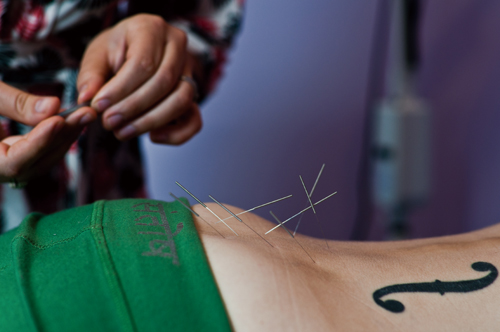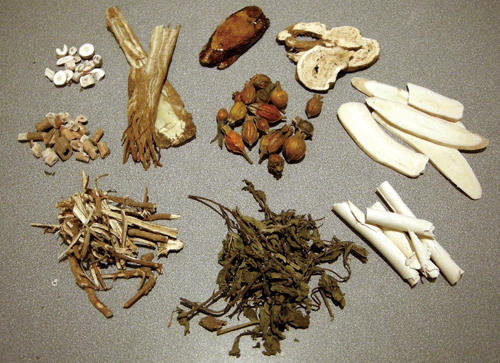
Once they’re a bit more settled in, many newcomers become curious about traditional Chinese medicine (TCM). TCM can seem as inaccessible as it is exotic, but at its core revolves around a very simple tenet: balance.
TCM views the body as a whole. Within this system, positive and negative elements – the yin (阴) and yang (阳) – should be in equilibrium in order to maintain good health. It is when the body is besieged by external factors like wind, heat, cold, and dampness that this balance can be destroyed.
The idea is that the body can not only avoid illness, but also heal itself by following the rules and rhythm of nature. This is why TCM practitioners prefer natural treatments (i.e. medicinal foods) rather than manufactured drugs.
TCM doctors diagnose imbalance by carefully examining factors ranging from a patient’s pulse to the sound of their breathing and the coating on their tongue. They also interview the patient about their symptoms, regular diet, and medical history. In this way, it is said that a good doctor can treat illness before its onset while a bad doctor will merely treat the illness itself. Here’s an introduction to basic TCM principles and techniques.
Food Therapy
In TCM, it is believed that food and medicine are derived from the same natural sources, which can all be used to treat illness. Ancient practitioners classified foods according to their effects on the balance of factors like cold and warmth or moisture and dryness within the body. For example, it’s recommended to drink green tea (which has “cold” properties) in the summer and black tea (which has “warm” properties) in the winter.
Generally, foods that take longer to grow have a “warmer” nature (温, wen) while foods that require less growing time have a “colder” nature (寒, han). Most root vegetables, including potatoes, ginger, garlic and carrots, are considered “warm.” Cooling foods include cucumber, eggplant, apples, and watermelons, which are all good to eat in the summer. Eating both kinds of foods in balance is the key to good health.
Acupressure
Acupressure or tuina (推拿) is as relaxing as it is therapeutic, so even a healthy person would benefit from this ancient healing art. This massage technique can help rid the body of accumulated toxins. The resulting blockages are thought to cause everyday aches and pains, which can lead to illness or injury if left untreated.
By applying consistent pressure to meridians and pressure points, a tuina expert can eliminate blockages and speed up the body’s ability to heal. Tuina is also used to treat chronic ailments like neck pain and sports injuries. Bear in mind that it is considerably more intense than your average spa massage and can result in some pain and discomfort.

Acupuncture
Acupuncture (针, zhen) is probably the most recognized TCM practice in the West and was included on the UNESCO Intangible Cultural Heritage Lists in 2010. In acupuncture, needles are inserted into the patient’s skin along meridians and pressure points. Some patients liken the insertion pain to a mosquito bite while others find it very uncomfortable; you are the best judge of your own pain threshold, so proceed accordingly. Acupuncture is commonly used to relieve acute pain and chronic conditions, but it’s also increasingly used to treat insomnia and obesity.

Moxibustion
If the needles still put you off, consider moxibustion (灸, jiu). The latter stimulates the same points as acupuncture, but using sticks of moxa made from dried mugwort burned above the patient’s skin. The heat generated by the combustion stimulates these pressure points and warms the meridians to boost energy (气, qi) and blood circulation. Due to its warming properties, moxibustion is often used in the winter to treat ailments like arthritis, poor digestion, and menstrual pain. Moxa smells somewhat like cheap tobacco, so avoid this technique if you’re sensitive to cigarette smell.
Ear Acupressure
Perhaps you’ve spotted strangers with tiny squares of plaster on their ears and wondered what that was all about. The plasters are filled with small pellets that make contact with the ears at different acupressure points. It is believed that each point corresponds to an internal organ, so applying pressure on it can relieve symptoms associated with that internal organ. For example, the earlobe is linked to the mouth and face while the middle ear is linked to digestive organs.
The pellets often consist of millet, mung beans, or cowherb seeds, which are stuck on the ear for a few days. Ear acupressure is said to be effective for treating headaches, insomnia, menstrual pain, and kidney disorders.

Cupping
In a cupping (拔罐, baguan) session, the doctor creates a vacuum by burning oxygen in a lightbulb-shaped glass bottle that is then placed over the skin, usually the back. The process stimulates circulation by drawing blood to the surface of the skin, leaving round red or purple marks that disappear after a week or two. Cupping is often performed in the winter to treat back and shoulder ailments.
Scraping
Scraping (刮痧, guasha), on the other hand, is mostly performed in the summer to eliminate excess “heat” (火, huo) in the body as a result of conditions like fever or heatstroke. A smooth-edged instrument is used to repeatedly rub the back until the skin turns red or purple. It’s recommended not to shower for 24 hours after cupping or scraping, as the skin is very sensitive from the treatment. Bear in mind that both cupping and scraping can be quite painful.

Herbal Medicine
There’s no two ways around it – Chinese medicine tastes pretty awful, a sentiment echoed in the proverb “good medicine tastes bitter” (良药苦口, liangyao kukou). But thanks to modern technology, many of these bitter compounds can now be ingested in powdered and pill form. In the past, herbal remedies were almost exclusively consumed in liquid “soup” form, which would make your entire apartment smell like a TCM pharmacy. Most hospitals and clinics can now process TCM herbs into individual portions of ready-to-drink liquid packages for your convenience.
You can also find over-the-counter TCM remedies at neighborhood pharmacies. Most Chinese families have a medical kit filled with go-to balms, tinctures, pills, and syrups. Just be sure to consult your doctor before taking anything, especially if you have a medical history of diabetes; many TCM remedies contain sugar to counteract bitterness and improve taste. Here are some common remedies:
A popular cough medicine is called Nin Jiom Pei Pa Koa (京都念慈庵蜜炼川贝枇杷膏, RMB 23), a pleasant herb-based remedy that contains honey and is effective for relieving sore throats.
If you have indigestion and need a replacement for Pepto-Bismol, try the Chinese equivalent: jiangzhong jianwei xiaoshi pian (江中健胃消食片, RMB 8.8). These chewable, milky tablets are made from hawthorn, roasted barley, orange peel, and ginseng, and don’t taste bad at all.
To relieve cold symptoms, try 999 Ganmaoling (999感冒灵, RMB 11). Simply dissolve a packet of power in boiling water and drink the solution three times a day.
Made from six herbs, liuwei dihuang wan (六味地黄丸, around RMB 10) is widely taken to relieve the back pain, fatigue, low energy, and hair loss associated with kidney deficiencies.
Resources:
Hongyitang 弘医堂
Affiliated with the Beijing University of Chinese Medicine, this well-respected TCM hospital offers treatments ranging from moxibustion to herbal medicine and bone setting. Registration fee is RMB 10-300. No English service, but most doctors speak some English.
Daily 8am-noon, 1.30-9pm. 2 Tuanjiehu Beilu, Chaoyang District (6582 7961/63) www.guoyitang.com 朝阳区团结湖北路2号
Beijing Tongrentang Traditional Chinese Medicine Hospital 北京同仁堂中医医院
RMB 5 for ordinary registration and RMB 30-200 for senior specialists. Good with traditional treatments and best with herbal medicine.
Daily 7.30-11am, 1-4.30pm. 46 Xidamochang Jie, Chongwen District (6701 9022/0215) www.tongrentangzyyy.com 崇文区西打磨厂街46号
Oasis International Hospital 明德医院
This international hospital has a comprehensive TCM clinic that accepts both appointments and walk-in patients. All the staff speak English and direct billing is available.
Mon-Fri 8.30am-5.30pm, Sat 8.30am-12.30pm (TCM clinic). 9 Jiuxianqiao Beilu, Chaoyang District (400 UR OASIS) www.oasishealth.cn 朝阳区酒仙桥北路9号
The Meridian 明经堂中医馆
This clinic is known for its friendly service and efficient treatment, with acupuncture and tuina particularly recommended. No registration fee for general treatments, RMB 300-400 for senior specialists.
Daily 9.30am-9.30pm. 9-10-A, Si’de Park, Fangyuan Xilu, Chaoyang District (139 1136 1184, 8456 7010) www.mingjingtang.com 朝阳区芳园西路四得公园9-10-A (近东四环霄云桥)
Joyful Bliss Wellness Center 金佰健康中心
Offers medical massage therapies, skincare, weight control help, and stress relief. Reasonable prices and English service.
Tue-Sun 10am-10pm. 3/F, 32 Liangmaqiao Lu, Chaoyang District (6436 4576, 136 1125 2085) www.caclinic.com 朝阳区亮马桥路32号高澜大厦附楼3层
Beijing Dongwen Integrative Clinic 北京东文中医诊所
This international clinic provides TCM treatments in Chinese, English, Japanese, French, German, and Arabic. Most of the practitioners are graduates of the Beijing University of Chinese Medicine and have worked overseas. Help is also available for stress, depression, and weight management.
Mon-Fri 9am-5.30pm, Sat-Sun 9am-8pm. Rm 107, Palace Hotel Beijing, 8 Xiaoyun Li, Chaoyang District (5613 7619) www.dywjmed.com 朝阳区霄云里8号酒店107室
This article originally appeared in the beijingkids 2014 Health Guide. Click here to read it on Issuu. For your free copy, contact our Distribution team at distribution@truerun.com.
Photos: philozopher, MarnieJoyce, SuperFantastic, and Renato Ganoza (Flickr)



